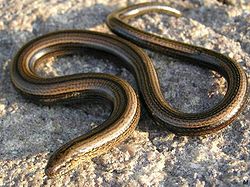
Anguis fragilis
Did you know...
SOS Children volunteers helped choose articles and made other curriculum material SOS Children works in 45 African countries; can you help a child in Africa?
| Anguis fragilis | |
|---|---|
 |
|
| Scientific classification | |
| Kingdom: | Animalia |
| Phylum: | Chordata |
| Subphylum: | Vertebrata |
| Class: | Reptilia |
| Order: | Squamata |
| Family: | Anguidae |
| Genus: | Anguis |
| Species: | A. fragilis |
| Binomial name | |
| Anguis fragilis Linnaeus, 1758 |
|
Anguis fragilis, or slow worm, slow-worm, slowworm, blindworm or blind worm, is a limbless reptile native to Eurasia.
Slow-worms are semi-fossorial (burrowing) lizards spending much of the time hiding underneath objects. The skin of the varieties of slow-worm is smooth with scales that do not overlap one another. Like many other lizards, slow-worms autotomize, meaning that they have the ability to shed their tails in order to escape predators. The tail regrows, but remains smaller.
These reptiles are mostly active during the twilight and occasionally bask in the sun, but are more often found hiding beneath rocks and logs. They are carnivorous and, because they feed on slugs and worms, they can often be found in long grass and other damp environments.
The females give birth to live young ( ovoviviparous birth). In the days leading up to birth the female can often be seen basking in the sun on a warm road.
They are common in gardens and can be encouraged to enter and help remove pest insects by placing black plastic or a piece of tin on the ground. On warm days one or more slow worms will often be found underneath these collectors of heat. One of the biggest causes of mortality in slow worms in suburban areas is the domestic cat, against which it has no defence.
Although these lizards are often mistaken for snakes, there are a number of features that differentiate them from snakes. The most important is they have small eyes with eyelids that blink like lizards. This is a feature that is not found in snakes. They may also have visible ears like lizards do, which snakes do not have. They shed their skin in patches like other lizards, rather than the whole skin as most snakes do. Slowworms also shed tails ( autotomy) by breaking one of their tail vertebrae in half, as a defence mechanism, as lizards do. Also, the pattern of their ventral scales is totally different from that of snakes.
Adult slow-worms grow to be about 50 cm long and are known for their exceptionally long life; it has been said that a slow-worm is the longest-living lizard, living about thirty years in the wild and up to fifty-four years in captivity (this record is held by a male slow worm that lived at the Copenhagen Zoo from 1962 to 2009) . The female often has a stripe along the spine and dark sides while the male may have blue spots dorsally. Juveniles of both sexes are gold with a dark brown belly and sides with a dark stripe along the spine.
Protected species in the UK
In the United Kingdom the slow worm has been granted protected status, alongside all other native British reptile species. The slow worm has been decreasing in numbers, and under the Wildlife and Countryside Act 1981 it is illegal to intentionally kill, injure, sell or advertise to sell them.
Taxonomy
- Anguis fragilis Linnaeus, 1758
- Anguis fragilis fragilis Linnaeus, 1758
- Anguis fragilis colchicus ( Nordmann, 1840)
The subspecies Anguis fragilis fragilis is found all over Europe, while Anguis fragilis colchicus is found in south-eastern Europe, the Caucasus and Iran.

